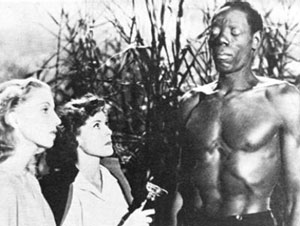The Dawn Of The Living Dead: I Walked With A Zombie
Published on September 29th, 2008 in: Halloween, Horror, Issues, Movie Reviews, Movies, Retrovirus |Tourneur and Hunt frequently shot the footage at a low angle, which furthered the impression that the audiences were looking up at the characters. This contrasted with the performances in an interesting way. We are increasingly aware of the characters’ vulnerabilities, the seemingly petty motivations behind their actions, and the ways in which they cope or otherwise can’t play the hand dealt them: Betsy’s unrequited love for her employer Paul Holland; the drinking problem his brother Wesley Rand (James Ellison) cultivates to prevent his guilt from getting the best of him. This is not the noble suffering portrayed in other films of the day. The characters seem smaller than those in the kinds of films in which Bette Davis or Henry Fonda starred.
The actors playing the lead roles further emphasized the smallness of these characters. Several stock performers under contract to the studio appear in the film, and while they surfaced in many other features during RKO’s heyday, they are all but unrecognizable to filmgoers today, making the fact that they were shot as though they were Cary Grant and Claudette Colbert almost poignant in retrospect. The actors’ approach to the film has a stagy quality that appears stylized in this post-Method age, and this further underscores the dreamlike quality of the film. Frances Dee underplayed Betsy to perfection, and her vulnerability in her pining for Paul Holland is palpable and heartbreaking.

The multiracial cast seems, at this historical remove, innovative and surprising. Most mainstream Hollywood movies of the 1940s cast non-white actors as either villains or in stereotypical roles that depicted them in an embarrassing light. The Caribbean supporting cast in Zombie doesn’t have this problem. Though the characters serve the Caucasian protagonists, they are portrayed respectfully—without the eye-rolling mannerisms or jive talk with which their peers were saddled. Lewton and Tourneur likewise portrayed voudoun with some reverence. Through the character of Holland’s mother, we learn about the history of voudoun on the island, and the ways in which non-native populations intersected with this spirituality.
I Walked with a Zombie did not quite replicate the runaway success of Cat People, which saved RKO from financial ruin. It did healthy business for its time, playing for several weeks at some of the most well-regarded picture houses across the country, and it also found a wide audience among servicemen serving in WWII. Like its predecessor, however, I Walked With A Zombie could be seen as anticipating the moment in which horror movies came of age. While many of the aesthetic progeny of the Universal horror pictures still play to packed houses, films that use both realistic and phantasmagorial elements to explore real-life concerns have also met with great acclaim.
Film scholars have speculated Lewton opened the door for Alfred Hitchcock’s Psycho and Vertigo, and some of the shots in I Walked With A Zombie influenced Maya Deren’s shorts At Land and Ritual In Transfigured Time. Guillermo del Toro, whose early effort The Devil’s Backbone shows the influence of Lewton’s efforts, has referred to Lewton and Tourneur as “the Lennon/McCartney of horror.” It doesn’t get much more influential or important than that.
Pages: 1 2
Time limit is exhausted. Please reload the CAPTCHA.